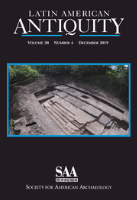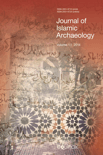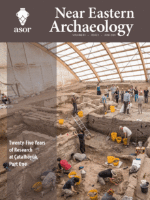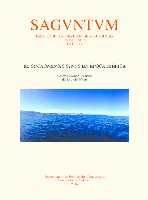
OLBA
Scope & Guideline
Cultivating a Community of Archaeological Inquiry
Introduction
Aims and Scopes
- Archaeological Research:
The journal emphasizes original archaeological studies and excavations, presenting new findings from sites across Anatolia and adjacent regions, which are crucial for understanding the historical and cultural development of these areas. - Epigraphical Studies:
OLBA publishes research focused on inscriptions, including their historical significance, context, and the insights they provide into ancient societies, particularly in relation to social, political, and religious practices. - Cultural and Historical Analysis:
The journal covers the interpretation of archaeological and historical data to analyze the interactions between different cultures, especially during periods of transition such as the Late Antique and Byzantine eras. - Material Culture and Artifacts:
Research on artifacts, including pottery, coins, and sculptures, is a key focus, highlighting their relevance in understanding ancient economies, trade, and daily life. - Interdisciplinary Approaches:
OLBA encourages interdisciplinary studies that combine archaeology with geography, anthropology, and history, fostering comprehensive insights into the ancient world.
Trending and Emerging
- Maritime Archaeology:
There is a growing interest in maritime activities and coastal settlements, as evidenced by recent studies focusing on harbors and their roles in trade and cultural exchange during ancient times. - Late Antique and Byzantine Studies:
Publications increasingly emphasize the Late Antique and Byzantine periods, exploring their complexities and transitions, reflecting a broader scholarly interest in these transformative eras. - Social and Political Structures:
Research examining the socio-political dynamics of ancient societies, particularly through inscriptions and architectural remains, has gained traction, indicating a shift towards understanding governance and community organization. - Technological Applications in Archaeology:
The integration of technology, such as digital epigraphy and remote sensing, is becoming more prevalent, showcasing the journal's commitment to modern methodologies in archaeological research. - Intercultural Interactions:
There is an emerging focus on the interactions between various cultures in ancient Anatolia, particularly during periods of conquest and migration, highlighting the complexities of cultural exchange and assimilation.
Declining or Waning
- Early Bronze Age Studies:
Research specifically focused on the Early Bronze Age appears to be less frequent in recent issues, possibly indicating a shift towards later historical periods or different archaeological contexts. - Generalized Historical Surveys:
Broad historical surveys that do not focus on specific archaeological findings or inscriptions are becoming less common, as the journal seems to favor detailed, site-specific studies that provide new data. - Traditional Art Historical Studies:
There is a noticeable decrease in traditional art historical analyses that do not incorporate archaeological findings or interdisciplinary methods, as the journal increasingly prioritizes empirical data.
Similar Journals

Adalya
Cultivating a Deeper Understanding of Historical ContextsAdalya, published by the esteemed Koc University Suna & Inan Kirac Research Center for Mediterranean Civilizations (AKMED), is a prominent academic journal dedicated to the fields of Archeology, History, and Conservation. With an ISSN of 1301-2746, this journal serves as an essential platform for scholars and researchers, fostering insightful discussions and disseminating significant findings about Mediterranean civilizations. Recognized in the quartile rankings of Q3 in Archeology and Q2 in both Conservation and History for the year 2023, Adalya reflects an impactful presence in its respective disciplines. Although it operates under a traditional subscription model, the journal remains accessible to a diverse audience interested in the nuanced exploration of historical contexts and conservation practices. Located in Antalya, Turkey, the journal has carved out a niche since its inception in 2009, bridging the past and present through rigorous academic inquiry. Whether you are a seasoned researcher or a student eager to deepen your understanding of Mediterranean cultures, Adalya offers invaluable resources and perspectives that enrich the academic community.

Ancient Asia-Journal of the Society of South Asian Archaeology
Connecting Scholars to the Wonders of Ancient AsiaAncient Asia - Journal of the Society of South Asian Archaeology, published by ARF India, stands as a pivotal resource for the exploration and dissemination of archaeological research focused on the rich history and culture of South Asia. Since its inception as an Open Access journal in 2006, it has become an essential platform for scholars and enthusiasts alike, boasting an impressive range of quartile rankings across multiple disciplines, including Anthropology, Archaeology, History, and Visual Arts. With expansion into various indexed categories and consistent dissemination of impactful research common to this highly diverse field, Ancient Asia aims to foster interdisciplinary dialogue, facilitate collaboration among researchers, and enhance the global understanding of ancient civilizations within the region. By embracing an inclusive access model, the journal encourages wide readership and engagement, positioning itself as a key player for students, professionals, and academics interested in delving into the archaeological marvels of South Asia.

LATIN AMERICAN ANTIQUITY
Pioneering Research in the Heart of Latin American HistoryLATIN AMERICAN ANTIQUITY is a prestigious journal published by Cambridge University Press, focusing on the archaeology and history of Latin America. With an impressive impact factor reflecting its critical role in the academic community, this journal exemplifies excellence in research, landing in Q1 across multiple categories, including Archaeology and History, as per the 2023 category quartiles. The journal's scope covers a broad range of topics related to pre-Columbian cultures, ancient civilizations, and historical developments, making it essential reading for researchers, professionals, and students keen on exploring the rich tapestry of Latin American heritage. Although it is not an open-access publication, LATIN AMERICAN ANTIQUITY remains a vital resource for those dedicated to advancing knowledge in this dynamic field. With its commitment to scholarly rigor and a strong ranking in Scopus, it serves as a cornerstone for academic dialogue and investigation.

Britannia
Navigating the Depths of Archaeological and Historical InquiryBrittannia is a prestigious journal published by Cambridge University Press that serves as a cornerstone for scholars and enthusiasts in the fields of Archaeology, Classics, and History. With its ISSN of 0068-113X and E-ISSN of 1753-5352, the journal has been committed to disseminating high-quality research and innovative studies since its inception in 1970, addressing vital topics that span cultural, historical, and archaeological dimensions. As a hallmark of academic rigor, it maintains a Q1 ranking in Classics and History and a Q2 ranking in Archaeology (both Arts and Humanities, 2023), reflecting its impact and significance in these disciplines. Although not an Open Access journal, it provides invaluable content for researchers, professionals, and students alike, ensuring that vital insights into ancient civilizations and cultural heritage resonate well beyond the pages of each issue. With upcoming publications scheduled through 2024, Brittannia continues to be an essential resource for anyone invested in the legacies of the past.

ZEITSCHRIFT DES DEUTSCHEN PALASTINA-VEREINS
Navigating the Intersections of History, Culture, and ReligionZEITSCHRIFT DES DEUTSCHEN PALASTINA-VEREINS is a distinguished academic journal published by VERLAG OTTO HARRASSOWITZ, focusing on interdisciplinary research in archaeology, cultural studies, history, and religious studies. With an ISSN of 0012-1169, this periodical has gained recognition for its valuable contributions to the understanding of historical and contemporary issues related to the Levant region, making it an essential resource for researchers, professionals, and students fascinated by these disciplines. The journal's performance in the academic community is bolstered by its Q2 and Q3 quartile rankings across various subject categories in 2023, including significant placements in cultural studies and religious studies, reflecting its impact and relevance. ZEITSCHRIFT DES DEUTSCHEN PALASTINA-VEREINS not only serves as a platform for scholarly discourse but also engages with current debates and methodologies, fostering a deeper appreciation for the complexities of Palestinian studies and contributing to a vibrant academic landscape. While the journal is not open access, it remains a critical venue for disseminating cutting-edge research and perspectives.

Journal of Islamic Archaeology
Exploring the Rich Tapestry of Islamic HeritageJournal of Islamic Archaeology is a distinguished publication dedicated to advancing the field of archaeology through the lens of Islamic heritage and culture. Published by EQUINOX PUBLISHING LTD, this journal provides a platform for researchers, professionals, and students to disseminate their findings and engage in critical dialogue regarding the archaeological aspects of Islamic societies from 2014 to the present. With an ISSN of 2051-9710 and E-ISSN 2051-9729, the journal is indexed within significant academic databases and positioned notably in the Q3 and Q2 quartiles for archaeology in the Arts and Humanities and Social Sciences categories, respectively. The journal fosters scholarly exchange and innovation, drawing attention to the rich tapestry of Islamic archaeology, and securing its role as an essential resource for practitioners and academics alike. Its commitment to rigorous peer-review and high-quality contributions ensures a valuable repository of knowledge, enhancing the understanding of an often underrepresented field in archaeology.

Vestnik Drevnei Istorii-Journal of Ancient History
Charting New Territories in Ancient StudiesVestnik Drevnei Istorii - Journal of Ancient History, published by the esteemed Russian Academy of Sciences and the State Academy of Humanities (GAUGN), plays a pivotal role in the interdisciplinary field of ancient studies. Fostering scholarly discourse since 2016, this journal is positioned at the crossroads of archaeology, classics, history, and linguistics, as evidenced by its impressive 2023 ranking in multiple categories, including Q1 in Classics and Q2 in History. Although not open access, it serves as a critical resource for researchers, professionals, and students interested in deepening their understanding of ancient societies and cultures. With a reputation for rigor and a commitment to advancing knowledge, the journal aims to disseminate innovative research that sheds light on the complexities of ancient civilizations and their contributions to contemporary society. Current issues and a wealth of archived articles are available for exploration, fostering a rich environment for scholarly engagement.

NEAR EASTERN ARCHAEOLOGY
Advancing Knowledge Through Archaeological DiscoveryNEAR EASTERN ARCHAEOLOGY, published by University of Chicago Press, is a premier journal dedicated to the field of archaeology, particularly focusing on the rich cultural heritage and archaeological findings of the Near East. With an ISSN of 1094-2076 and an E-ISSN of 2325-5404, this esteemed publication provides a vital platform for scholars and practitioners to share their research, insights, and discoveries. The journal holds an impressive ranking in the Q1 quartile for both Archaeology and History in 2023, reflecting its significant impact within these fields and a robust history of scholarly contribution. The journal has been pivotal in shaping discussions around archaeological methodology, theory, and contemporary issues from 2002 to 2024, as it continues to reach a wide audience through various access options. With Scopus rankings placing it in the top percentiles for both History and Archaeology, NEAR EASTERN ARCHAEOLOGY represents an essential resource for researchers, professionals, and students alike, fostering the exploration and understanding of the region's archaeological narrative.

SAGVNTVM-Papeles del Laboratorio de Arqueologia de Valencia
Pioneering Insights into the Archaeological Landscape of Valencia.SAGVNTVM-Papeles del Laboratorio de Arqueologia de Valencia is an esteemed open-access journal dedicated to advancing the field of archaeology, published by the Department of Prehistory and Archaeology at the University of Valencia, Spain. With an ISSN of 0210-3729 and an E-ISSN of 2174-517X, the journal has been a vital resource for scholars since its inception in 1962, ensuring that high-quality archaeological research is readily available to the global academic community. Notably, it holds a distinguished Q2 ranking in both Archeology and Archeology within the arts and humanities categories as of 2023, reflecting its commitment to rigorous scholarship and significant contributions to the field. The journals' Scopus rankings further affirm its relevance, positioned at #188 of 413 in Arts and Humanities and #179 of 354 in Social Sciences. Researchers and professionals alike can delve into a variety of topics, benefiting from the journal’s rich archive from 2017 to 2023. With a mission to disseminate knowledge and foster dialogue in archaeology, SAGVNTVM serves as an essential platform for investigators, students, and practitioners interested in the latest archaeological findings and methodologies.

JOURNAL OF EGYPTIAN ARCHAEOLOGY
Advancing Knowledge in Egyptology and BeyondJOURNAL OF EGYPTIAN ARCHAEOLOGY is a premier publication dedicated to advancing the study of ancient Egyptian culture, artifacts, and historical contexts. Published by SAGE PUBLICATIONS LTD in the United Kingdom, this journal has been an authoritative source of archaeological scholarship since its inception in 1964. It boasts an impressive reputation, currently holding a Q3 ranking in Archeology and Q2 rankings in both Archeology (arts and humanities) and History for 2023, underlining its importance in its field. With a focus on interdisciplinary research, the journal provides a platform for in-depth analysis and discussion among scholars, researchers, and students alike. The journal is also indexed in Scopus, with notable rankings that reflect its influence and reach within the academic community, especially among arts and humanities disciplines. Although it is not an Open Access publication, the insights offered through its meticulously curated articles are invaluable for anyone looking to deepen their understanding of Egyptology and archaeological practices. For scholars seeking to engage with contemporary discussions in this fascinating field, the JOURNAL OF EGYPTIAN ARCHAEOLOGY serves as an essential resource.